Scotch Macaskill's Wildlife Blog
IMPORTANT: Please note that from April 2009 this Blog's Web address changed as a result of a switch in the blogging platform we use. It's still an integral part of the Wildlife Pictures Online website and, we hope, will continue providing entertaining and enjoyable content in the form of wildlife images, news, views and information.
For the most recent posts, links, and other resources, please visit the new Wldlife Photography Blog.
|
Today's Picture: Warthog on its Knees Digging for Roots
March 4, 2009
|
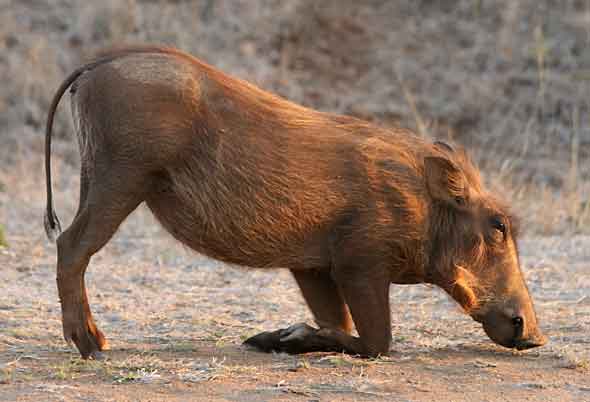
Photo Details: Female warthog (Phacochoerus africanus) on its knees, about to dig for grass roots, Kruger National Park, South Africa.
Camera: Canon EOS 400D (Canon Rebel XS 10.1MP); Lens: Canon 70-300 F4-5.6 IS USM; Focal Length: 165mm; Shutter speed: 1/50; Aperture: f5.6; ISO: 200.
Additional Info: Warthogs prefer to eat short grasses but as winter approaches and grass is in short supply, they spend most of the day rooting for rhizomes (grass roots) using the hard cartilaginous disc on the end of their noses.
They kneel down to do this as in the picture above and consequently are able to root in hard, sun-baked ground and develop large callouses on their front “knees” as a result. To find out more about these ugly but fascinating animals, see Roddy Smith's article, How the Warthog got its Name and other Interesting Warthog Facts.
|
Today's Picture: Redheaded Weaver Collecting Building Material
March 8, 2009
|
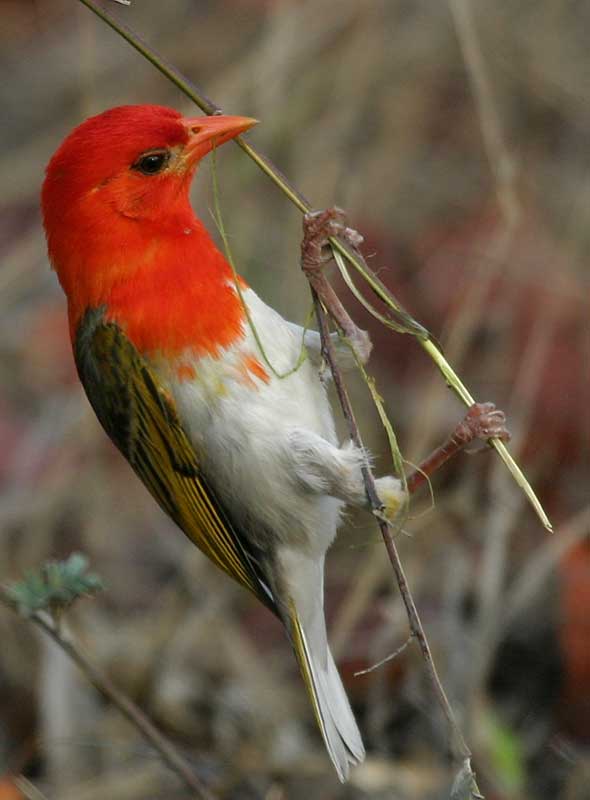
Photo Details: Redheaded Weaver (Anaplectes rubriceps) in bright breeding plumage uses its beak to strip a twig while gathering building material for a new nest, Kruger National Park, South Africa.
Camera: Canon EOS Digital Rebel; Lens: Canon 100-400 IS zoom; Focal Length: 390mm; Shutter speed: 1/400; Aperture: f5.6; ISO: 400.
Additional Info: In breeding season male weavers are conspicuous in their bright plumage as they compete for females, at the same time making themselves more vulnerable to predators. Read more about these attractive little birds, their intricate nest-building, and their mating habits in Roddy Smith's article, Weaver Birds Brighten Up Our Lives.
|
Today's Picture: Male Lion Marking his Territory
March 12, 2009
|
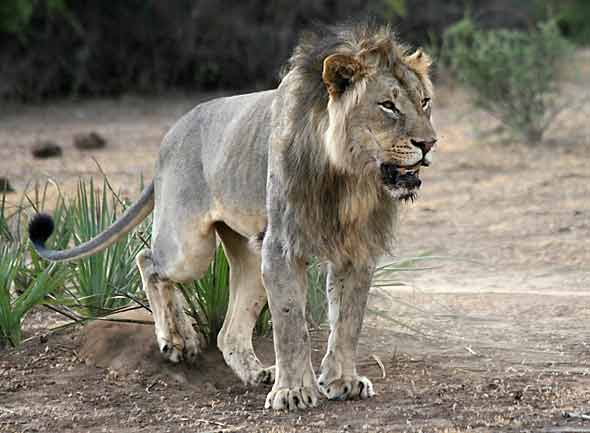
Photo Details: Male lion (Panthera leo) performing scuffing ceremony to mark his territory, Mashatu Game Reserve, Tuli Block, Botswana.
Camera: Canon EOS 400D (Canon Rebel XS 10.1MP); Lens: Canon 70-300 F4-5.6 IS USM; Focal Length: 240mm; Shutter speed: 1/500; Aperture: f5.6; ISO: 400.
Additional Info: Male lions within a pride regularly mark the boundaries of their defended territory by spraying urine on bushes and other landmarks. This is often followed by the scuffing ceremony where the lion rakes the ground with his back feet a number of times, as in the picture above.
"Prominent objects bordering roads, paths, kopies, water holes, and solitary trees tend to become regular scent posts that reek of lion urine", explains Richard Despard Estes in his book,
The Behavior Guide to African Mammals . .
|
Today's Picture: Hippo Yawning, Side View
March 18, 2009
|
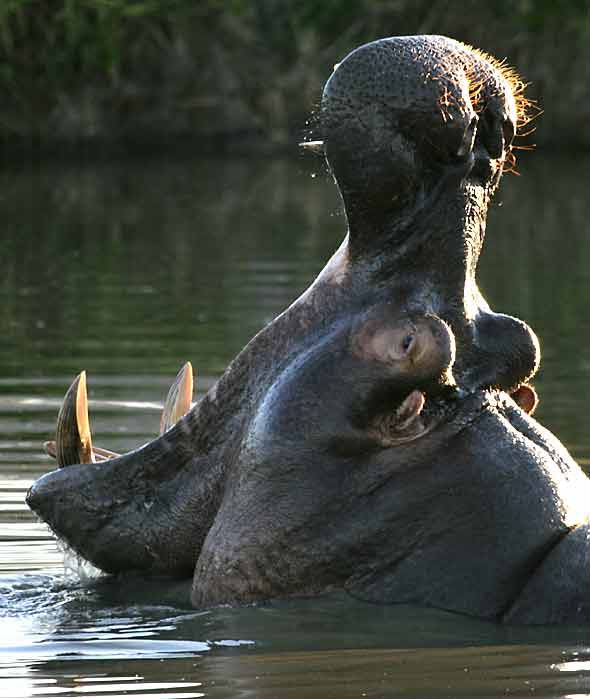
Photo Details: Hippopotamus (Hippopotamus amphibius) yawning, side view showing the long, sharp tusks in the lower jaw, Elephant Plains Game Reserve, Sabi Sand, South Africa.
Camera: Canon EOS 400D; Lens: Canon 100-400 IS Zoom; Focal Length: 400mm; Shutter speed: 1/160; Aperture: f5.6; ISO: 200.
Additional Info: The hippo's yawning display is a means of showing off its huge jaws and large incisor and canine teeth to competitors and intruders. The lower canines or tusks are kept razor sharp by honing against the shorter, upper canines. Armed with such dangerous weapons, adult male hippos when fighting can cause each other serious, sometimes fatal, injuries.
Safari guide Roddy Smith, who has been canoeing the Zambezi River and its side-channels for more than 20 years, believes hippos are much-maligned by humans. See his article, Hippos - is their Bad Reputation Deserved? for more.
|
Today's Picture: Lion Cubs Going Walkabout
March 26, 2009
|
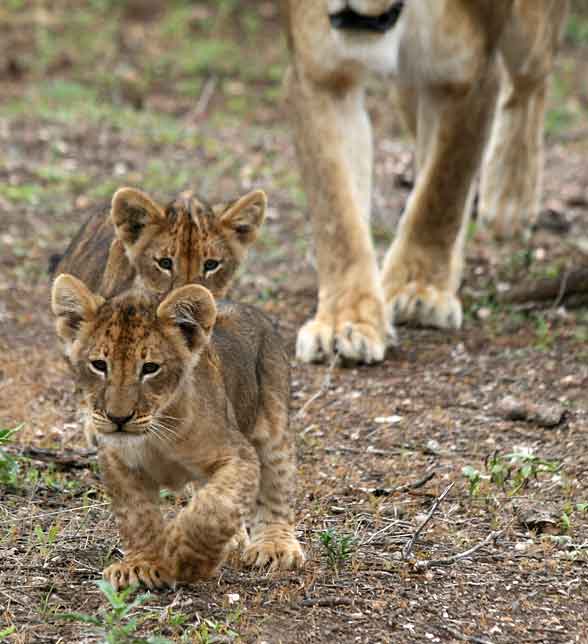
Photo Details: A pair of lion cubs (Panthera leo) striding out boldly with their mother following in the background, Mashatu Game Reserve, Tuli Block, Botswana.
Camera: Canon EOS 400D Digital; Lens: Canon EF70-300mm f/4-5.6 IS USM; Focal Length: 180mm; Shutter speed: 1/800; Aperture: f5.6; ISO: 400.
Additional Info: Most people now accept that global warming is a reality. Ancients like me probably won't be around to see the worst effects of climate change. But for the coming generations, it's a reality that will have possibly devastating consequences.
So I thought it appropriate to feature an image of youngsters going boldly forward, under the watchful but diminishing influence of the older generation. Unfortunately for the lions and other animals of the planet, both young and old, they can't make a difference.
But people can. Earth Hour is a worldwide campaign to raise awareness of global warming by encouraging people to switch off their lights for one hour - from 8.30pm to 9.30pm - local time on Saturday 28 March.
According to the Earth Hour website, "2,848 cities, towns and municipalities in 84 countries have already committed to VOTE EARTH for Earth Hour 2009, as part of the world's first global election between Earth and global warming."
The Vote Earth! website says: "This year, Earth Hour has been transformed into the world’s first global election, between Earth and global warming. For the first time in history, people of all ages,
nationalities, race and background have the opportunity to use their light switch as their vote – Switching off your lights is a vote for Earth, or leaving them on is a vote for global warming.
WWF are urging the world to VOTE EARTH and reach the target of 1 billion votes, which will be presented to world leaders at the Global Climate Change Conference in Copenhagen 2009."
You can find out more from the Earth Hour website.
|
| |
| Back to top of page
|
|
Previous Entries
By Month
By Category
My Original Blog
2005 Entries
2004 Entries
2003 Entries
Who Am I?
Brief Bio
|





